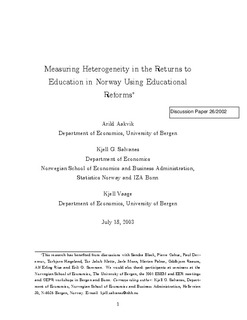Measuring heterogeneity in the returns to education in Norway using educational reforms
Working paper
Permanent lenke
http://hdl.handle.net/11250/162894Utgivelsesdato
2003-07Metadata
Vis full innførselSamlinger
- Discussion papers (SAM) [657]
Sammendrag
The decision to take more education is complex, and is influenced by individual
ability, financial constraints, family background, preferences, etc. Such factors,
normally unobserved by the researcher, introduce endogeneity and heterogeneity
problems into estimating the returns to education. In this paper, these problems
are addressed by estimating a comparative advantage model for schooling, in
which the returns to education vary at different levels of education. The model
requires that instruments must be specified at each level of education, and we
suggest that different school reforms in Norway can serve as suitable instruments.
In particular, we exploit the staged implementation of a major reform in the
comprehensive school system in the 1960s. We find that the returns to education
are strongly nonlinear. In particular, we find that the returns to upper secondary
school and shorter programs at regional colleges, together with master’s programs
at universities, have high returns as measured by wages. Also, we find that the
average treatment effect is surprisingly high for medium-length educations (up
to two years of college education). This means that increasing the general level
of education, which was the intention of the comprehensive school reform of the
1960s and of other school reforms, has the potential to generate a high return in
wages, although we do not consider the cost to society. We also find that there
is a substantial difference between the average treatment effect and the effect of
treatment on the treated for bachelor’s and master’s degrees at universities.
Utgiver
Norwegian School of Economics and Business Administration. Department of EconomicsSerie
Discussion paper2002:26
